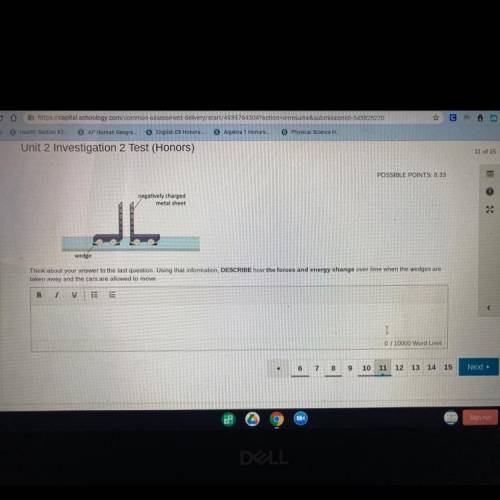
Physics, 11.05.2021 01:00, JellalFernandes
Describe how the forces and energy change over time when the wedges are taken away and the cars are allowed to move?


Answers: 2
Other questions on the subject: Physics

Physics, 22.06.2019 03:00, lananamr
Dinate system, and a charge q = - 2.00 nc is placed s2 10 n> c. (a) what is the change in electric potential energy when the dipole moment of a molecule changes its orientation with respect to es from parallel to perpendicular? (b) at what absolute temperature t is the average translational kinetic energy 32 kt of a molecule equal to the change in potential energy calculated in part(: abovethistemperature, thermalagitationprevents the dipoles from aligning with the electric field.) placed in a uniform electric field e with magnitude 1.6 * 6 on the positive x-axis at x = 4.00 cm. (a) if a third charge q3 = +6.00 nc is now placed at the point x = 4.00 cm, y = 3.00 cm, find the x- and y-components of the total force exerted on this charge by the other two. (b) find the magnitude and direction of figure p21.62 ll uu 21.55 . torque on a dipole. an electric dipole with dipole moment ps is in a uniform external electric field es. (a) find the orientations of the dipole for which the torque on the dipole is zero. (b) which of the orientations in part (a) is stable, and which is unstable? (hint: consider a small rotation away from the equi- librium position and see what happens.) (c) show that for the stable orientation in part (b), the dipole’s own electric field tends to oppose the external field. 21.62 ..
Answers: 1

Physics, 22.06.2019 12:40, live4dramaoy0yf9
Question part points submissions used suppose that 2 j of work is needed to stretch a spring from its natural length of 26 cm to a length of 36 cm. (a) how much work is needed to stretch the spring from 28 cm to 32 cm? (round your answer to two decimal places.)
Answers: 2

Physics, 22.06.2019 16:00, blythephillips2734
An charge with mass m and charge q is emitted from the origin, (x, y)=(0,0). a large, flat screen is located at x=l. there is a target on the screen at y position y(h), where y(h) > 0. in this problem, you will examine two different ways that the charge might hit the target. ignore gravity in this problem. 1.assume that the charge is emitted with velocity v(0) in the positive x direction. between the origin and the screen, the charge travels through a constant electric field pointing in the positive y direction. what should the magnitude e of the electric field be if the charge is to hit the target on the screen? express your answer in terms of m, q, y(h), v(0), and l. 2.now assume that the charge is emitted with velocity v(0) in the positive y direction. between the origin and the screen, the charge travels through a constant electric field pointing in the positive x direction. what should the magnitude e of the electric field be if the charge is to hit the target on the screen? express your answer in terms of m, q, y(h), v(0), and l.
Answers: 1
Do you know the correct answer?
Describe how the forces and energy change over time when the wedges are taken away and the cars are...
Questions in other subjects:


Mathematics, 08.11.2019 17:31





Mathematics, 08.11.2019 17:31

Spanish, 08.11.2019 17:31








